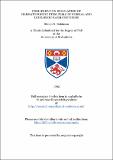Files in this item
Proliferation regulation of haematopoietic stem cells in normal and leukaemic haematopoiesis
Item metadata
| dc.contributor.advisor | Riches, Andrew Clive | |
| dc.contributor.author | Robinson, Simon N. | |
| dc.coverage.spatial | 355 p., 7 p. of plates. | en_US |
| dc.date.accessioned | 2018-07-05T09:42:29Z | |
| dc.date.available | 2018-07-05T09:42:29Z | |
| dc.date.issued | 1992 | |
| dc.identifier.uri | https://hdl.handle.net/10023/14965 | |
| dc.description.abstract | The cellular integrity of the blood is maintained by the cellular output of the haematopoietic stem cell population which produces the specialized precursors and differentiated cells which constitute the blood. The investigation of haematopoietic stem cell behaviour and regulation has been hampered by both the difficulty in their identification and the development of relevant assay systems. The purpose of this investigation was to study the behaviour and regulation of the haematopoietic stem cell population in normal and leukaemic haematopoiesis using an in vitro assay of a primitive haematopoietic precursor. The use of a combination of haematopoietic colony-stimulating factors [interleukin 3 (IL3)/multi-CSF and macrophage colony-stimulating factor (M-CSF/CSF-1)] in semi-solid agar culture of murine haematopoietic tissue, stimulated the proliferation of a haematopoietic colony-forming cell, defined as the "HPP-CFCIL3+CSF-1" population, which was characterized by a high proliferative potential, a multipotency and behavioural and regulatory properties consistent with its being a primitive haematopoietic precursor and possibly a component of the haematopoietic stem cell population. The proportion of the in vitro HPP-CFCIL3+csf-1 population in S-phase in normal murine marrow, was determined to be relatively low at approximately 10%, increasing to approximately 40% in sublethally X-irradiated, regenerating murine marrow and the respective presence of the haematopoietic stem cell proliferation inhibitor and stimulator was demonstrable by the induction of appropriate kinetic changes in the in vitro HPP-CFCIL3+CSF-1 population. In leukaemic haematopoiesis, leukaemic proliferation often occurs at the expense of apparently suppressed normal haematopoiesis. In vitro HPP-CFCIL3+CSF-1 assay of the haematopoietic stem cell proliferation regulators in a number of murine, myeloid leukaemic cell lines, failed to demonstrate either increased levels of the haematopoietic stem cell proliferation inhibitor, or evidence of a direct-acting, leukaemia- associated proliferation inhibitor, however, evidence of a leukaemia- associated impairment of inhibitor and stimulator production was observed and this may be a possible mechanism by which the leukaemic population develops a proliferative advantage over normal haematopoietic tissue. The identification of a possible mechanism of leukaemic progression and suppression of normal haematopoiesis may subsequently allow the development of potentially more effective disease treatment and management regimes. The endogenous haemoregulatory tetrapeptide: Acetyl-N-Ser- Asp-Lys-Pro [AcSDKP, Mr=487 amu] is reported to prevent the G0-G1 transition of haematopoietic stem cells into S-phase. The mechanism of action of AcSDKP and a number of related peptides, was investigated in relation to the stem cell proliferation stimulator and inhibitor. AcSDKP demonstrated no direct haemoregulatory role against the in vitro HPP-CFCIL3+CSF-1 population, which is consistent with reports that AcSDKP is not active against cells already in late G1, or S-phase, rather it appeared to act indirectly by impairing the capacity of the haematopoietic stem cell proliferation stimulator to increase the proportion of the in vitro HPP-CFCIL3+CSF-1 population in S-phase. An apparent impairment of stimulator action may explain the reported AcSDKP-associated 'block' of haematopoietic stem cell recruitment. A putative endogenous AcSDKP precursor and synthetic and degradative enzyme systems have been reported and the possible physiopathological role of AcSDKP in a number of myeloproliferative disorders has been implicated. The potential application of AcSDKP as a 'haemoprotective' agent administered prior to the use of S-phase- specific chemotherapy may be of clinical significance. The in vitro HPP-CFCIL3+CSF-1 assay of a primitive haematopoietic precursor cell population, which may be a component of the haematopoietic stem cell population, should play a significant role in the investigation of haematopoietic stem cell behaviour and regulation in both normal and aberrant haematopoiesis. With the characterization of the mechanism(s) of action of the haematopoietic stem cell proliferation inhibitor and stimulator and the haemoregulatory tetrapeptide AcSDKP, the manipulation of the haematopoietic system to clinical advantage can be envisaged, while the identification of the aberrant regulatory mechanism(s) in haematopoietic dysfunction may allow, the development of more effective disease treatment and management regimes. | en_US |
| dc.language.iso | en | en_US |
| dc.publisher | University of St Andrews | |
| dc.subject.lcc | QP92.R7 | |
| dc.subject.lcsh | Formation--Hematopoiesis--Bone marrow | en |
| dc.title | Proliferation regulation of haematopoietic stem cells in normal and leukaemic haematopoiesis | en_US |
| dc.type | Thesis | en_US |
| dc.contributor.sponsor | Leukemia Research Fund | en_US |
| dc.type.qualificationlevel | Doctoral | en_US |
| dc.type.qualificationname | PhD Doctor of Philosophy | en_US |
| dc.publisher.institution | The University of St Andrews | en_US |
This item appears in the following Collection(s)
Items in the St Andrews Research Repository are protected by copyright, with all rights reserved, unless otherwise indicated.

